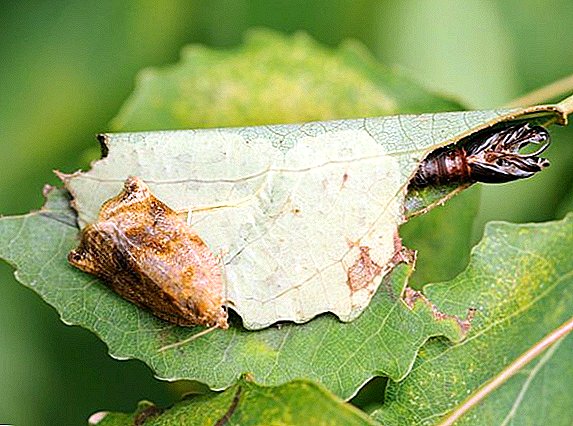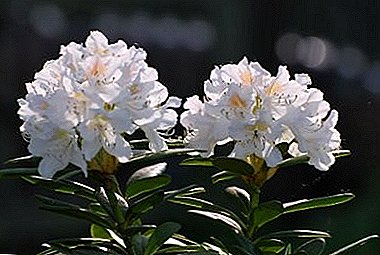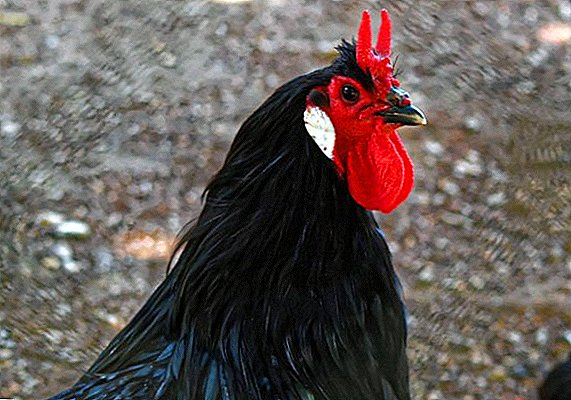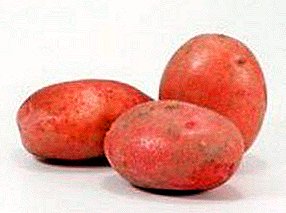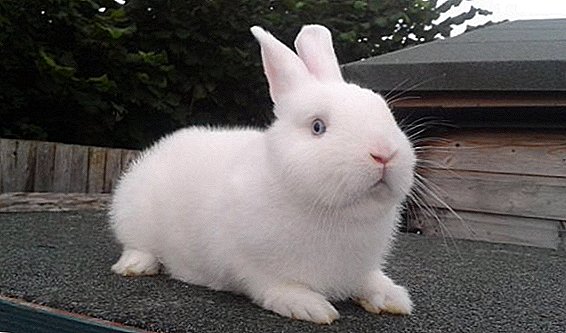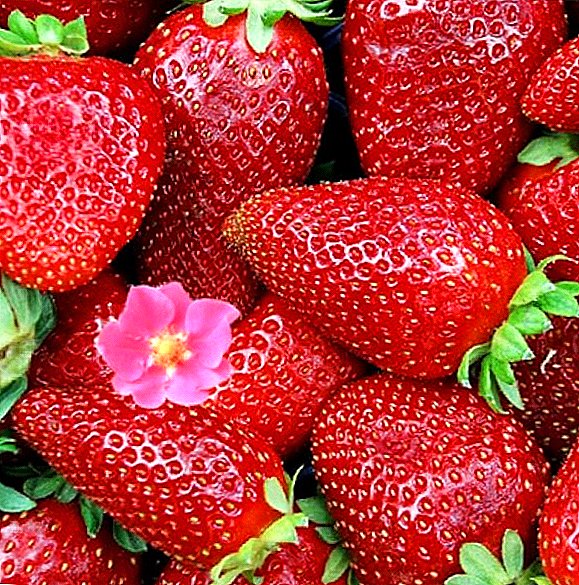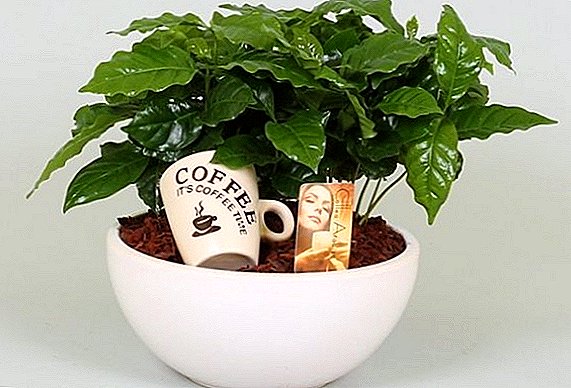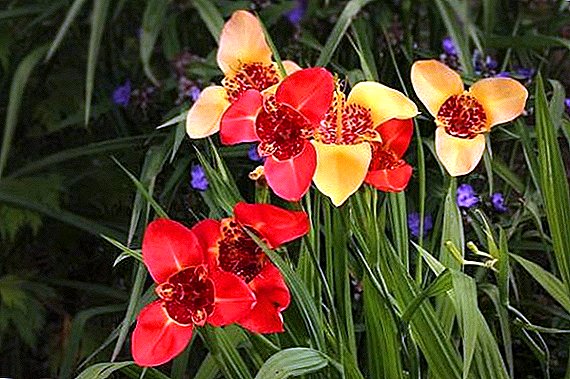 Tigridia - a bright and unusual flower that conquers with its elegance and variety of its shades. This perennial herb is widely known among gardeners all over the world. However, flower lovers often refuse to grow it on their own plot, as they consider that it is too difficult to provide him with the necessary conditions. Let's see if this is true, and also find out what conditions are necessary for the successful cultivation of tigridia.
Tigridia - a bright and unusual flower that conquers with its elegance and variety of its shades. This perennial herb is widely known among gardeners all over the world. However, flower lovers often refuse to grow it on their own plot, as they consider that it is too difficult to provide him with the necessary conditions. Let's see if this is true, and also find out what conditions are necessary for the successful cultivation of tigridia.
Botanical description
Tigridia is a variety of perennial herbaceous plants native to South America, the Iris family. In height of a plant reach from 30 to 70 cm.
The Iris family also includes plants such as: babiana, crocus (saffron), freesia, montbrecia, gladius.
The rhizome has a dense bulbous formation of irregular shape, typical for tigridia, about 6 cm long and up to 4 cm wide. From above, the bulb is covered with dry, membranous formations of dark brown shades.
Leaves are strap-shaped, with a corrugated surface and a bright green shade. They rise above the ground surface in the form of a fan straight from the basal rosette. In the center of the fan of the leaves is a simple or branched erect stem.  The flowering period in tigridia lasts from the first half of July to the first autumn frosts. From one bulb grows about 6 peduncles, each of which bears on itself 2-3 buds. The corolla consists of 6 petals, 3 of them are much larger than the others.
The flowering period in tigridia lasts from the first half of July to the first autumn frosts. From one bulb grows about 6 peduncles, each of which bears on itself 2-3 buds. The corolla consists of 6 petals, 3 of them are much larger than the others.
The diameter of the corolla is in the range of 8–15 cm. As a result, the irregular size of the petals of the tigridia forms the characteristic triangular or square shape of the flower.
The outer edge of the flower has bright shades of red, pink or yellow, but the color may be more delicate, snow-white tones.
Did you know? BUTIn the XIV-XVI centuries, the Tstec used tigridia bulbs for food. They were baked and used as a main dish or side dish.
Closer to the center of the flower is a characteristic for the iris ornament in the form of pronounced divorces. The duration of its life is no more than 10 hours, but the flowers open in turn, therefore, to create a decorative effect, tigridia are planted in small groups.
In a group of two dozen plants, 5-7 flowers will bloom every day.  The flowering period of one plant does not exceed 30 days.
The flowering period of one plant does not exceed 30 days.
After flowering on the plant ripen the fruit-boxes, which carry several angular brown seeds. Tigridia is propagated with the help of seeds or bulbs. By the end of the growing season, the bulb is depleted, instead of it a nest of young onion matures on the rhizome.
Kinds
Today, there are about 55 species of tigridia, but few among gardeners around the world have become particularly popular. The most common representatives of all 2 types: tubular tigridia and peacock tigridia.
Tigridia peacock - it is a heat-loving flower, the natural habitat of which is considered to be the regions of Mexico and Guatemala.  Tigridia peacock A distinctive feature of the species is the alternate opening of the buds, thereby achieving uniform flowering, as well as a large corolla with red or purple petals with a diameter of about 15 cm.
Tigridia peacock A distinctive feature of the species is the alternate opening of the buds, thereby achieving uniform flowering, as well as a large corolla with red or purple petals with a diameter of about 15 cm.
The most popular varieties of this species are:
- "Alba": it is characterized by snow-white flowers and a bright spotty ornament of scarlet color;
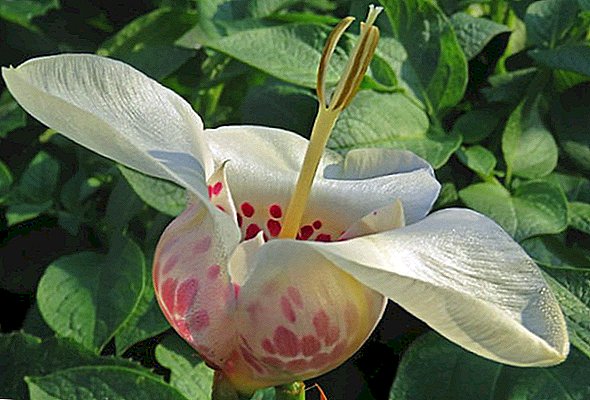
- "Aureya": a plant with yellow flowers and a carmine-colored pattern in the form of stains;

- Carminea: it is distinguished by bright orange flowers with yellow ornamentation;

- "Lilacie": the variety has lilac-red petals and carmine spots at their base;

- "Rosalind": flower with delicate, light pink petals and scarlet pattern;

- "Specialty": a plant with characteristic scarlet-red flowers, as well as red or golden yellow spots.

Did you know? One of the pioneers of tigridia is considered the Spanish missionary Bernardino de Sahagun. In the XVI century, in his book "The General History of New Spain Affairs", a monk described the plant for the first time in detail, and also revealed its main features.
Tigridia tubular - heat-loving plant, the natural habitat of which are the mountainous regions of Mexico.  Tigridia tubular A characteristic feature of the species is its smaller size. The height of the plant does not exceed 40-50 cm, the diameter of the flower is no more than 7 cm. The outer petals of the flower are more rounded than those of their relatives, and also have a delicate, light pink shade.
Tigridia tubular A characteristic feature of the species is its smaller size. The height of the plant does not exceed 40-50 cm, the diameter of the flower is no more than 7 cm. The outer petals of the flower are more rounded than those of their relatives, and also have a delicate, light pink shade.
Tigridia Chess - A hybrid species, featuring an unusual color petals. They are covered with numerous small specks of two shades. The spots are arranged alternately, which creates a unique chess ornament.  Tigridia Chess Tigridia many-flowered - a plant of medium size, with a characteristic burgundy color of flowers and a dark pattern at the base. One of the most striking features of the plant is the unusual shape of its outer petals. They are strongly bent outward, which gives an unusual look to the whole flower.
Tigridia Chess Tigridia many-flowered - a plant of medium size, with a characteristic burgundy color of flowers and a dark pattern at the base. One of the most striking features of the plant is the unusual shape of its outer petals. They are strongly bent outward, which gives an unusual look to the whole flower.  Tigridia many-flowered
Tigridia many-flowered
Bulb reproduction
Planting bulbs is one of the most common methods of growing tigridia at the dacha. In addition, only with the help of bulbs can achieve the most efficient and high-quality shoots.
Also, bulbs reproduce such flowers as: tulip, snowdrop, autumn crocus, gladiolus, lily, narcissus, ixia, candike, allium, hionodoksa and dahlia.
The process consists of the following steps:
- Choosing a landing site: A plot suitable for a future flower should be chosen in the fall; Best for the plant fit places with well-drained and light soil.
- Preparation for landing: 3-5 days before the estimated date of planting, the nest of the bulbs is divided into individual bulbs and kept at room temperature.
 Tirgidia bulbs
Tirgidia bulbs - Planting planting: The optimal period for the landing of tigridia is mid-May. The bulbs are planted in a pre-loosened soil to a depth of about 10 cm. The first shoots appear after 2-3 weeks.
- Plant care: For the first few weeks, the bulbs require intensive hydration before the emergence of shoots, so that the moisture will saturate the developing root system to the maximum. After the appearance of the first shoots, the amount of water is reduced, and watering is carried out as necessary, however, drying of the substrate should not be allowed.
Important! When planting, the thickening of plantations should be avoided, as this may adversely affect the overall growth and development of the flower bed. The minimum distance between individual flowers should be at least 20 cm.
To improve the efficiency of reproduction of tigridium, it is important to use the following recommendations:
- Tigridia is a light-loving look that does not tolerate abrupt changes in atmospheric conditions, so the flower will feel best in a well-lit area, protected from drafts.
- Inhabitants of the northern regions are recommended to pre-germinate bulbs. To do this, they are planted in pots with good drainage for several weeks before planting, in the open ground the plant is transplanted after the germination of the first 2 leaves.
- Often, plants do not require additional garters, but in the case of cultivation with insufficient light, the stem becomes brittle and requires binding.

Winter storage
At the end of the growing season, several children develop in the root zone of the flower around the uterine bulb. Already next spring, they can sprout. This is the so-called nest of bulbs, which is the planting material.
Dig it in late September, before the first cold snaps, along with the dried aerial part of the flower. After that, corms are kept at room temperature in a well-ventilated place for 2 weeks to eliminate excess moisture.
After 14 days, the dried-up parts of the roots and leaves are cut off without disturbing the structure of the corms and leaving a hemp of about 3 cm in length. Next, tigridia should be treated with any potent fungicide for plants.
Important! If the room for the storage of bulbs there is high humidity, they should create special conditions, providing good ventilation. To do this, instead of sand, they are placed in a nylon mesh and suspended.
The simplest option would be a 0.7% emulsion of foundation. After that, corms are again dried at room temperature for 1-2 weeks.  Prepared bulbs are placed in a container and wrapped in dry clean sand. In this form, the bulbs are stored in a cool place at a temperature of about 5 ° C. A few days before landing, the nests are withdrawn and divided into individual onion. Planting material with obvious signs of damage or rot is discarded.
Prepared bulbs are placed in a container and wrapped in dry clean sand. In this form, the bulbs are stored in a cool place at a temperature of about 5 ° C. A few days before landing, the nests are withdrawn and divided into individual onion. Planting material with obvious signs of damage or rot is discarded.
Cultivation from seeds
Growing tigridia from seeds has been practiced successfully in most northern regions, because due to the climatic characteristics of the flower bulb, they do not have time to ripen safely before the first cold weather.
The dates of sowing seeds for each climate zone are individual. In a temperate climate, the process starts at the end of February.
Seeding consists of the following steps:
- Substrate and vessel preparation: any garden containers will be suitable for growing seedlings, they can be replaced with disposable plastic cups. For the cultivation of seedlings fit any store substrate. Soil can be prepared and personally, from a mixture of sod land, peat and sand in a ratio of 2: 1: 1.
- Packing with a substrate of garden containers: the soil in the germination tank should be filled thoroughly, however, its excessive density must also be avoided, as this may adversely affect the growth of the seedlings.
- Sowing seeds: it is carried out in a superficial way; To do this, seed should be evenly distributed over the surface of the substrate and cover with a layer of soil no more than 3 mm.
- Sowing care: the first few weeks, the substrate should be moistened abundantly with settled water at room temperature. After the appearance of the first shoots, it is not necessary to re-moisten the soil; watering should be done as the substrate dries. Best of all, the seed containers will feel warm and brightened at a temperature of 20-25 ° C.
- Transplanting in open ground: transplanted seedlings should be in the second half of May, after maturation on it the first 2 leaves. After planting plants for 2 weeks should be watered abundantly.
 Tirgidia seeds
Tirgidia seedsBasic recommendations for improving seed multiplication of tigridia:
- To protect the seedlings from fungal infections, seeds before sowing should be soaked for 5 minutes in a 40% water-alcohol solution, then rinsed thoroughly.
- When sowing seeds, one should strictly observe the distance between them not less than 5-6 cm, thus it will be possible to avoid the thickening of sowing.
- After planting tigridia in open ground, it is imperative to feed them; for this, any liquid fertilizer will be suitable for seedlings from the nearest flower shop.
Plant Care
Like any other plant, tigridia require special conditions of detention for themselves, without which they will not be able to see a blooming flower bed.
Lighting
As mentioned above, tigridia is a photo-loving look, but it should not be planted on the brightly lit side of the flower bed, as direct sunlight can adversely affect the development of the flower.
Therefore, they should be planted in a well-lit place, but hidden from direct exposure to the sun.
Temperature
The flower belongs to the heat-loving plants, so for its successful development in the active growing season, the air temperature should be at least 20 ° C.
Important! A flower may grow at a temperature below 20 ° C, but in this case it will not be able to form mature bulbs or seeds.
However, in the autumn, the light frosts of tigridia are not terrible, so they manage to delight with their flowering up to severe cooling.
The soil
Tigridia grows best on light fertile and well-drained soils, protected from strong winds, with a neutral or alkaline pH.  Such soil should be subject to good agricultural practices and pre-fertilized with a small amount of mineral or organic fertilizers.
Such soil should be subject to good agricultural practices and pre-fertilized with a small amount of mineral or organic fertilizers.
Find out what is important soil acidity for plants, how to determine the acidity of the soil on the site, as well as how to deoxidize the soil.
Watering
During the period of germination and active seedlings, tigridia require daily watering to maintain good humidity, but it is not worth re-moistening the plants, as this can lead to their death. In hot periods, the flowers are watered 1-2 times a day, while the daytime temperature drops to 20 ° C - once every 1-2 days.
The main sign of the need for moisture is the appearance of a light dry crust on the ground. At the end of flowering, tigridia are prepared for wintering, for this, from the end of July, watering is halved, to 1 time in 2-3 days.
Humidity
Tigridia are moisture-loving plants, however, excessive moisture is bad for their development and general condition.
Therefore, it is necessary to grow this flower in a dry, well-ventilated place (but without drafts). During irrigation, watering the plants themselves is not worth it, just moisten the soil of the flowerbed. 
Top dressing
Top dressing for this flower is vital. For the first time fertilized plants a month after the appearance of the first 2 leaves, or not earlier than 2 weeks after transplanting to a permanent place.
Next time feed tigridium at the stage of active budding.
The plants respond best to fertilizing with complex fertilizers for flowering species.
Important! During the period of active flowering, tigridia should not be fed up, at this stage the plant needs only proper watering.
Often, the manufacturer’s recommendations for their application fully meet the needs of the plants, but if you want to create a truly spectacular flower bed, then when you first feed you need to add 30-40 grams per square meter to the soil. m nitrogen fertilizer.
When budding, it is recommended to bloom the flower with a solution of nitroamofoski with a concentration of 30 g per 10 liters of water.
Difficulty growing
Serious problems in the cultivation of tigridia does not cause, however, difficulties in its breeding are still possible. During the growing season, the grower may experience wilting of flowers, the death of individual specimens and other things.  In most cases, this is a result of improper watering, feeding, etc. Therefore, a healthy, richly blooming flower bed of tigridia is possible only with strict observance of the rules described above for the care of the plant.
In most cases, this is a result of improper watering, feeding, etc. Therefore, a healthy, richly blooming flower bed of tigridia is possible only with strict observance of the rules described above for the care of the plant.
Diseases and pests
Tigridia are often affected by the following infectious diseases:
- Tobacco Mosaic Virus: causes a change in the color of the leaves on the characteristic marble pattern with beige or pink divorces, and also leads to the appearance of bumps on their surface. Today, effective anti-mosaic drugs do not exist, therefore, to prevent its development, it is necessary to use high-quality seeds and bulbs for reproduction of tigridia, annually dispose of fallen leaves and other plant residues at the end of the summer season, disinfect planting material and garden tools with alcohol solutions or other antiseptics.
- Rusty: It appears as a rounded formation on the surface of the plant. They can be of various sizes and shapes, but always contain a bright red powder that spills out when they crack. To overcome the disease, the flower must be treated with solutions of Alfa-Tebuzol, Flutrivit, Polygard, or analogues.
- Scab: the disease is manifested by focal infectious lesions on the plant surface, which are characterized by peeling of the upper layers of tissues, ulcers, warts, irregular-shaped patches. To prevent the disease, preventive spraying of flowerbeds is carried out 2-4 times per season with solutions of the preparations Fitosporin-M, Agat-25K, Albit, Acrobat MC, Profit Gold, Ordan, Kuproksat to choose or analogues.
- Rotten: appear focal spotty lesions of leaves and shoots of the plant. In each spot, the fabric turns into a pasty-like viscous substance of white, brown or black color. It is possible to overcome the disease with the help of Kuproksat solution or Bordeaux mixture.
In addition, tigridia suffer from pests:
- Medvedka: eats the roots and bulbs of the flower, which causes it to wilt. To identify the pest can be on small bumps and minks in the soil with a diameter of several centimeters. To prevent the development of a bear, before planting, it is imperative to pickle Fury, Aktar, Anticuc, Decis, Confidor, or its counterparts.
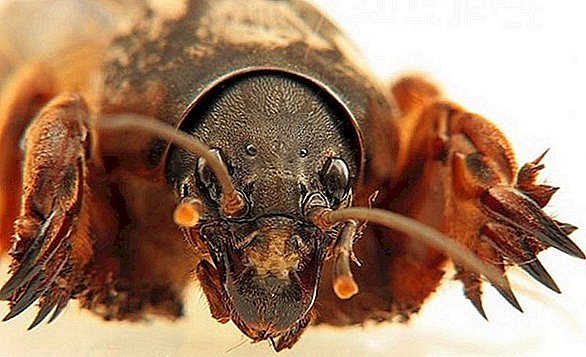 Medvedka
Medvedka - Trips: it is possible to determine the pest by the characteristic small black dots on the foliage. In the case of large-scale development of the parasite causes dry ulcers, as well as twisting and dying of the leaves. Also a distinct sign of the insect is the characteristic dry netting on the leaves. Thrips can be overcome with the help of "Avertina N", "Abamektina", "Aktelikta", "Agrovertina", "Fitoverma" or analogues.
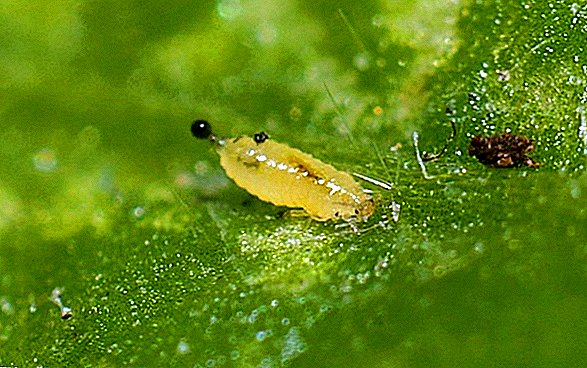 Trips
Trips - Slugs: the pest eats the young parts of the plant, which causes inhibition of the overall development of the flower. You can identify slugs by a characteristic whitish trail of mucus on the plant and nearby soil. You can overcome the parasite with the help of chemicals such as Mesurol, Glanzit, Snacol or analogues.
Feedback from network users
Plant height 30-40 cm. Grows rapidly.
The peculiarity of Tigridia is that the flower blooms early in the morning and fades late in the evening, and the next day a new inflorescence appears, most often of a different color. And so on until the fall. Magnificent view is complemented by a wonderful aroma.
Propagated by bulbs. For the winter I dig and store as gladioli. I plant early in the spring, as soon as the threat of frost has passed. Unpretentious, require a minimum of care and watering. Grow on almost any soil.
Great for decorating the site. If you want to surprise your neighbors with an unusual flower, feel free to choose Tigridia. Everyone who saw Tigridia on my site really liked the flowers.

Tigridia is an elegant exotic flower that pleases gardeners around the world with its bright appearance. Despite its origin, the plant does not require special conditions even in regions with northern climates.
However, in order for the flower only to delight you throughout the growing season, it should create special soil conditions and watering, otherwise it will not be possible to achieve a rich flowering.








 Tirgidia bulbs
Tirgidia bulbs Medvedka
Medvedka Trips
Trips